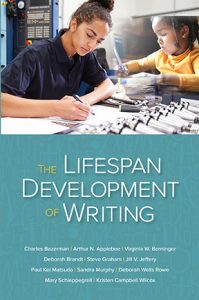This post was contributed by NCTE member Chuck Bazerman.
I began scribbling 70 years ago; I’m still scribbling. I began working with young scribblers over 50 years ago as a classroom assistant in the first Head Start program; now I work with undergraduate and graduate scribblers. All writers keep working at it and it never seems to get easy.
You’d think we would have learned by now. Actually, we each individually and collectively have learned a lot, but there is no end to learning to write. We struggle to form letters and spell words, then we struggle with increasingly ambitious school assignments, then we struggle to write as professionals and citizens. We keep having to solve new problems and develop new approaches to writing. After a lifetime, we are still apprentices.
Every writer knows this, but collectively, as educators, we have tended to have a narrower focus on the students we work with, whether in preschool, primary school, middle school, secondary school, higher education, or career and workplace. We teachers rarely get the opportunity to focus systematically on what students have learned before they walk into our school or classroom and what they will do with writing after they have left.
Over the last five years I have had the wonderful luxury to actually talk across the boundaries of education levels with scholars of writing to begin to understand how writing develops across the lifespan. Depending on the age or nature of students you work with, you may recognize some of their names: Arthur Applebee, Virginia Berninger, Deborah Brandt, Steve Graham, Jill Jeffery, Paul Kei Matsuda, Sandra Murphy, Deborah Wells Rowe, Mary Schleppegrell, and Kristen Wilcox.
These colleagues work with young children and mature adults and students at every level in between. They work with people with great variation in socioeconomic background, physical and neurological abilities, and language background. These colleagues are versed in psychology, disability studies, and neuroscience; emergent literacy, linguistic theory, and second language learning; curriculum and assessment design; teacher professional development and urban education; and composition and rhetoric. And of course they themselves are all writers.
The group’s combined perspectives helped us address the great complexity, variety, and multi-dimensionality of writing. The group met in face-to-face retreats, virtual seminars, and endless email exchanges. It was eye-opening and intense as we learned from each other’s experience and research specialties. Sometimes we got into conflicts as we struggled to understand the perspectives we all brought, but we each came away with a much richer understanding about the many things that enter into the growth of writers and how individual each person’s writing experience was.
 The product of the group’s discussion is the volume The Lifespan Development of Writing, just out from NCTE. Over time we came to agree on some basic principles about understanding and investigating how individuals develop as writers through many experiences in school, before school, out of school, after school.
The product of the group’s discussion is the volume The Lifespan Development of Writing, just out from NCTE. Over time we came to agree on some basic principles about understanding and investigating how individuals develop as writers through many experiences in school, before school, out of school, after school.
School of course is important to learning to write, but writing development is more than a march through a curriculum. Even students who experience the same curriculum respond to it differently and take different things away from it. Trying to understand how intertwined yet distinct curriculum and development were was one of the thorniest issues we addressed, and much still needs to be done on it.
Another related challenge was curing ourselves of normative expectations for typical development. We kept recognizing there is no typical; everyone writes in a different way and develops down a different path. When you think about it, this is obvious: we don’t expect people to write the same thing. We prize individuality of statement. Yet institutional needs to assess students against a standard and to create common lessons and expectations for many students lead us to seek ways to make the writing of different students comparable to each other, which means treating them as similar. So much of our discussion centered on how to characterize the complex multidimensionality of writing development.
Between the jointly written framing chapters of the volume exhibiting our shared thinking are individually authored chapters presenting our various research and thought. You can see that table of contents here. These middle chapters show the richness and variety of points of view in our discussions and the many directions ongoing work might take. This book aims to carry forward a discussion that we are just beginning.
So here it is, as the Duke of Gloucester is reported to have said to Edward Gibbon on the presentation of the first volume of The Decline and Fall of the Roman Empire: “Another damn’d thick, square book! Always, scribble, scribble, scribble.” We certainly hope so.

Charles Bazerman, Distinguished Professor of Education at the University of California, Santa Barbara, inquires into academic writing, the role of writing in society, and how writing forms and transforms people and societies. He is founder and former chair of the International Society for the Advancement of Writing Research, former chair of the Conference on College Composition and Communication, and the author of many articles and books, including the Handbook of Research on Writing: History, Society, School, Individual, Text and What Writing Does and How It Does It: An Introduction to Analyzing Texts and Textual Practices.

